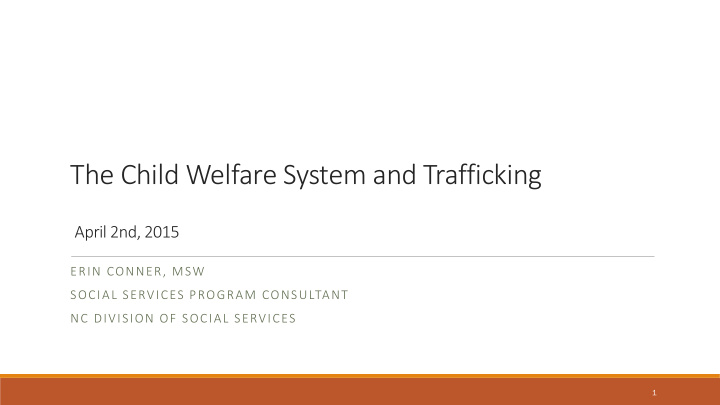



The Child Welfare System and Trafficking April 2nd, 2015 ERIN CONNER, MSW SOCIAL SERVICES PROGRAM CONSULTANT NC DIVISION OF SOCIAL SERVICES 1
Description of Session The presenter will summarize the current policy and practices of local Departments of Social Services and the state Division of Social Services and highlight opportunities for improvements to include those described in Preventing Sex Trafficking and Strengthening Families Act of 2014. 2
Goals of Session (Presenter) Provide brief background information on the purpose of the child welfare system Summarize why child welfare workers need to be aware of this issue and discuss the vulnerabilities of children who come into contact with the child welfare system Provide an overview of policy (where we are now), and opportunities to improve (where we would like to be) Discuss current Division initiatives and processes for improving policy around child trafficking Briefly discuss provisions of P.L. 113-183 and implications for the child welfare system in North Carolina 3
Goals of Session (Participants) Understand and describe the basic purpose of the child welfare system Identify vulnerabilities of children who come into contact with the child welfare system Demonstrate a basic understanding of child welfare policy and processes, as well as opportunities to strengthen child welfare response to trafficking Describe current Division initiatives and/or policy revision currently underway at the Division designed to address child trafficking, including the impact of P.L. 113-183 4
Child Welfare System: In a Nutshell The child welfare system is a group of services designed to promote the well-being of children by ensuring safety, achieving permanency, and strengthening families to care for their children successfully. How the Child Welfare System Works (The Child Welfare Information Gateway, February, 2013) 5
Child Welfare System Flow Chart Professional or community member Situation does not meet the State’s definition Suspected child abuse or reports suspected abuse to CPS. Worker of maltreatment, or too little information is neglect screens report. supplied. Report is “screened out.” Caller may be referred elsewhere. Report is “screened in.” Safety concerns exist Safety concerns and risk There are no safety concerns and/or risk is significant. are moderate. and the risk is low. CPS may conduct a CPS Investigates Family Assessment 6
Child Welfare System Flow Chart CPS may conduct a CPS Investigates Family Assessment Evidence of abuse or Child welfare or Insufficient evidence of No services are found to community-based neglect “Substantiated” abuse or neglect be appropriate. Family services may be offered or “Founded “Unsubstantiated” or may be referred to address family needs. “Unfounded” elsewhere. Child has been harmed and risk of future abuse or ongoing Low or no risk of future Case closed. safety concerns are present. abuse found. Family may be referred for voluntary services. 7
Child Welfare System Flow Chart Court petition Child stays with family. Child has been harmed and may be filed. Services are provided to future risk of abuse or ongoing the child and family. safety concerns are present. Child is placed in out-of-home care and services are provided to the Risk is minimized. child and family. Case is closed. Termination of parental rights Independent living with Reunification with Custody to a relative. and adoption or permanent permanent family family. legal guardianship. connections. 8
Why do Child Welfare Workers need to be aware of human trafficking? Trafficking could be occurring simultaneously with other forms of maltreatment in a single case Prior maltreatment of a child or youth could contribute to that child or youth being vulnerable to traffickers Parents, family members, and other caregivers could be the traffickers Emerging data indicates that child protection workers are encountering children and youth who have been trafficked 9
What makes children in the Child Welfare System more vulnerable? Lack of supervision, parental involvement, or familial support Previous history of abuse and trauma and/or history of family dysfunction, substance abuse, or domestic violence Limited social support system, low self-esteem Cognitive limitations, mental or emotional health issues Community conditions such as poverty, high rates of crime, existence of an adult prostitution market and large populations of transient people (truckers, tourists, military personnel, etc.) Certain populations ◦ LGBTQ youth ◦ American Indian youth 10
Child Welfare Policy Child Protective Services (CPS) ◦ Intake and Screening ◦ Assessment ◦ In-Home Services Child Placement ◦ Foster Care 11
Preventing Sex Trafficking and Strengthening Families Act (P.L. 113-183) ◦ Requires child welfare agencies to report the annual number of children in foster care who are identified as sex trafficking. ◦ Requires child welfare agencies to demonstrate that they have consulted with other specific agencies having experience with youth at-risk and have developed policies and procedures, including caseworker training, to identify, document in case records, and determine services for children and youth who have been trafficked or are at risk of being trafficked. ◦ Requires child welfare agencies to develop and implement protocols to locate children missing from foster care, determine factors that lead to the child’s being absent from care, and determine the child’s experiences while absent from care. 12
Opportunities to Strengthen Policy Current Policy Revision in Process Other Opportunities ◦ Intake ◦ Development of practice guide for child welfare workers ◦ Placement (Foster Care) ◦ Training ◦ Forms revision and/or other data collection revision ◦ PNR work groups 13
Questions? Erin Conner, MSW Social Services Program Consultant – Child Welfare Policy NC Division of Social Services erin.conner@dhhs.nc.gov 14
Recommend
More recommend